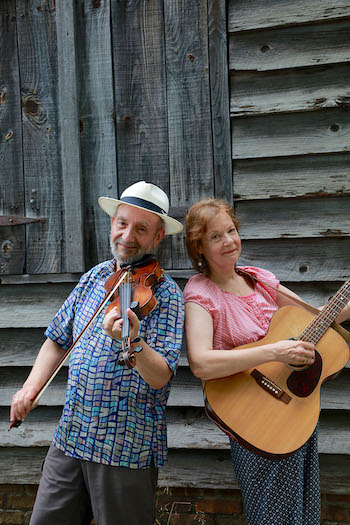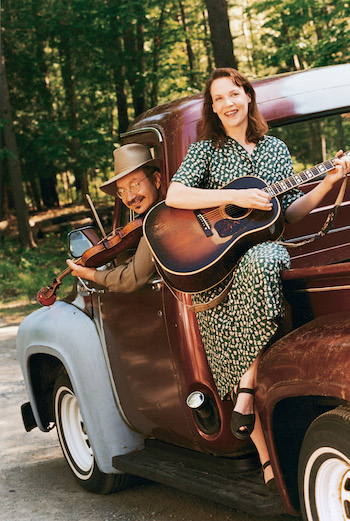Music Interview: Jay Ungar and Molly Mason — Still Playing Together After All These Years
By Ed Symkus
The renowned duo of Jay Ungar and Molly Mason perform what has been called American Roots music. But they’ve also been known to include traditional folk and ’40s jazz.
Here’s the short version of the musical and personal relationship between Jay Ungar and Molly Mason. She’s a pianist, guitarist, and bass player from Washington State. He’s an all-around string guy — but mostly a fiddler — from the Bronx. They met in 1977, when Ungar and his group, The Putnam String County Band, were playing a gig at the Towne Crier Café in Hopewell Junction, New York, and Mason — initially an audience member — played an opening set.
In ensuing years, Mason was in a trio with Ungar and his then-wife Lynn Hardy. She later joined Ungar’s quintet Fiddle Fever, and in 1985, after Ungar and Hardy split, began playing with him in duo format. They were married in 1991. The marriage and the duo performances are still in full swing. Their best-known songs are Ungar’s hauntingly beautiful “Ashokan Farewell,” which was featured in the Ken Burns film The Civil War, and the gentle “The Lovers’ Waltz,” which they co-wrote.
Ungar and Mason will perform at First Parish Meetinghouse, 535 Canton Ave., Milton, on April 12 at 7 p.m.
Tickets are $35. The pair recently took part in a phone interview from their home in West Hurley, New York.

Jay Ungar and Molly Mason today. Photo: courtesy of the artist
The Arts Fuse: It’s always nice to start from the beginning. How did each of you get into playing music?
Jay Ungar: When I was six, I saw somebody playing a concertina on TV. I started saying I wanted music lessons, but it took until I was seven until my parents gave in. They took me to a teacher who was purported to teach a lot of different instruments. But he didn’t teach concertina. He could teach piano, violin, clarinet, and other wind instruments. He started playing a few of them for me, and when he got to the violin, his primary instrument, it spoke to me. I said, “That’s what I want to play.”
Molly Mason: I started playing piano when I was 8 because it was the most accessible lesson thing for kids at the time. When I was 12, I got my parents to give me a guitar, and I started taking lessons on public television from Laura Webber. Years later, I bought a better guitar; a friend traded my old one in for a bass, and I started playing with a bluegrass band when their bass player couldn’t make a gig. Then I switched to being a guitar player.
AF: What was happening in your musical careers just before you met?
JU: I was in the Putnam String County Band, which had technically broken up. But we were still doing our annual holiday show at the Towne Crier Café in December.
MM: I grew up in Washington State, and came east, traveling in a car with my boyfriend. I brought my guitar and bass with me, and played six little folk gigs with The Mosley Sisters. My friend Suzy took me to the Towne Crier to see this band that Jay was in, and I played an opening guest set.
JU: So, we met when we were both performing the same night in the same place in two different ensembles.
AF: Jay, when you two perform, you go back and forth between fiddle and mandolin, and Molly, you’re on piano and guitar, and you both sing. What you play has been referred to as American Roots. But you’ve also been known to include traditional folk and ’40s jazz. How would you describe what you’ll be doing in Milton?
JU: We have three or more streams of music. One is the slow, deeply heartfelt, sometimes mournful or inspirational melodies. In another zone, there’s fiddle dance music. Another direction would be a broader path — the ’40s swing, which might also include more bluesy stuff.

Jay Ungar and Molly Mason decades ago. Photo: courtesy of the artist
MM: We often do something from Stephen Foster. He’s got some classics and we sometimes play them.
AF: So, it’s clear that you play lots of different styles of music. But you seem to have a connection to waltzes. What has drawn you to that genre?
MM: Probably a little bit of personal taste. I think because we played a lot of dances in the early part of our career, and you had to know some beautiful waltzes. And we both have an attraction to beautiful melodies.
JU: We’ve played a lot of contra dances and square dances, and there’s a frequent thing where, before the break or just at the end of the evening, there would be a waltz. And I’d notice that people at contra and square dances would frequently play a waltz in a way that did not recognize the potentially deep emotional content of the tune. I felt that these waltzes had to be looked at in a different way.
AF: Aside from live concerts, you’ve been doing your free “Quiet Room” shows on Facebook since the start of the pandemic. How do they differ from your stage shows?
JU: We do things that we never do in front of a live audience. We make up a theme and then try to come up with stuff to fit it.
MM: We sort of figure them out the day of. We just did our fourth-year anniversary show in March. They’re much looser than our stage performances, because we’re sitting in our living room. We’re on every Wednesday at 8 p.m., and we haven’t missed one. You can see them at Facebook.com/jayandmolly.
Ed Symkus is a Boston native and Emerson College graduate. He went to Woodstock, interviewed Albert Brooks, Joyce Carol Oates, Dan Hicks, and Christopher Nolan, and has visited the Outer Hebrides, the Lofoten Islands, Anglesey, Mykonos, the Azores, Catalina, Kangaroo Island, Capri, and the Isle of Wight with his wife Lisa.
